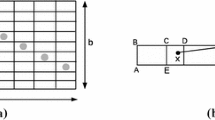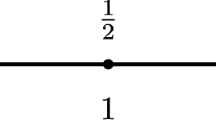Abstract
Let \(G\) be a random geometric graph formed by \(n\) nodes with adjacency distance \(r_n\) and let each edge of \(G\) be assigned an independent exponential passage time with mean that depends on the graph size \(n.\) We connect \(G\) to two nodes source \(s_A\) and destination \(s_B\) at deterministic locations spaced \(d_n\) apart in the unit square and find upper and lower bounds on the minimum passage time between \(s_A\) and \(s_B\) through paths in \(G\) having constant stretch, i.e., whose length is constrained to be proportional to the Euclidean distance between \(s_A\) and \(s_B.\)


Similar content being viewed by others
References
Alon, N., Spencer, J.: The Probabilistic Method. Wiley Interscience, New Jersy (2008)
Bradonjic, M., Elsasser, R., Friedrich, T., Sauerwald, T., Stauffer, A.: Efficient Broadcast on Random Geometric Graphs. Proc. SODA 2010, 1412–1421 (2010)
Ferrero, R., Gandino, F.: Analysis of random geometric graph for wireless network configuration. Proc. ICMU 2017, 1–6 (2017)
Franceschetti, M., Dousse, O., Tse, D.N.C., Thiran, P.: Closing Gap in the Capacity of Wireless Networks via Percolation Theory. IEEE Trans. Inf. Theory 53, 1009–1018 (2007)
Galambos, J.: Asymptotic Theory of Extreme Order Statistics. Wiley, New Jersy (1978)
Gandham, S.R., Dawande, M., Prakash, R., Venkatesan, S.: Energy efficient schemes for wireless sensor networks with multiple mobile base stations. Proc. GLOBECOM 2003, 377–381 (2003)
Ganesan, G.: Infection spread in random geometric graphs. Adv. Appl. Probab. 47, 164–181 (2015)
Ganesan, G.: Stretch and diameter in random geometric graphs. Algorithmica 80, 300–330 (2018)
Gupta, P., Kumar, P.R.: Critical Power for Asymptotic Connectivity in Wireless Networks, pp. 2203–2214. Stochastic Analysis, Control, Optimization and Applications (1998)
Meester, R., Roy, R.: Continuum Percolation. Cambridge University Press, Cambridge (1996)
Muthukrishnan, S., Pandurangan, G.: The bin-covering technique for thresholding random geometric graph properties. Proc. SODA 2005, 989–998 (2005)
Penrose, M.: Random Geometric Graphs. Oxford University Press, Oxford (2003)
Zennaro, D., Ahmad, A., Vangelista, L., Serpedin, E., Nounou, H., Nounou, M.: Network-wide clock synchronization via message passing with exponentially distributed link delays. IEEE Trans. Commun. 61, 2012–2024 (2013)
Acknowledgements
I thank Professors Rahul Roy, C. R. Subramanian and the referees for crucial comments that led to an improvement of the paper. I also thank IMSc for my fellowships.
Author information
Authors and Affiliations
Corresponding author
Additional information
Publisher's Note
Springer Nature remains neutral with regard to jurisdictional claims in published maps and institutional affiliations.
Appendices
Appendix 1: Edge weight assigments
Let \(\{W_{j_1,j_2,j_3}\}_{j_1,j_2,j_3 \ge 1}\) be i.i.d. random variables with cumulative distribution function (cdf) \(F_n\) that are also independent of the node locations \(\{X_i\}.\) We first describe edge weight assignments and then discuss the conditional independence property.
Edge weight assignments To assign weights to the edges of the random graph \(G\) from the set \(\{W_{j_1,j_3,j_4}\},\) we follow an analogous procedure as in Chapter \(1\) of Meester and Roy [10]. The basic idea is to first assign each node \(X_j,\) a unique pair of positive integers \(m(X_j) := (q,l_j).\) Next if \(X_i\) and \(X_j\) are joined by an edge \((X_i,X_j)\) in \(G,\) then we define the passage time \(t(X_i,X_j) := W_{q,l_i,l_j}.\) The integer pair \((q,l_j)\) is obtained by dividing the unit square \(S\) into successively finer subsquares of size \(\frac{1}{2^{q}}, q \ge 1\) each, until each subsquare contains at most one node of \(\{X_i\}.\)
Formally, for \(k \ge 1\) divide the unit square \(S\) into disjoint \(\frac{1}{2^{k}} \times \frac{1}{2^{k}}\) squares \(\{S_{k,l}\}_{1 \le l \le 2^{2k}}.\) Let \(q\) be the smallest integer such that each square in \(\{S_{q,l}\}\) contains at most one node of \(\{X_i\}.\) If node \(X_j\) is present in square \(S_{q,l_j},\) we then set \(m(X_j) := (q,l_j).\)
We illustrate the above procedure in Fig. 3, where the unit square \(ABCD\) is first subdivided into \(4\) subsquares each of side length \(\frac{1}{2}.\) This partition is not fine enough since the square \(AEFG\) contains two nodes \(x\) and \(y.\) Further subdividing \(\frac{1}{2} \times \frac{1}{2}\) subsquare into \(4\) subsquares each, we get a fine enough partition so that each subsquare contains at most one node.
Conditional independence property We use the following conditional independence property throughout. For any measurable function \(g = g(X_1,\ldots ,X_n)\) and any \(i \ne j,\) we have
We then say that given the node locations \(\{X_i\},\) the passage times \(\{t(X_i,X_j)\}\) are independent in the sense of (A1.1).
Appendix 2: Deviation estimates
We use the following deviation estimate throughout. Let \(\{R_j\}_{1 \le j \le m}\) be independent Bernoulli random variables with
and let \(R = \sum _{j=1}^{m} R_j.\) If \(p_{low} \le p_j \le p_{up}\) for all \(1 \le j \le m\) then then
for all \(m \ge 1.\)
Proof of (A2.1): Letting \(\mu = {\mathbb {E}}R\) and \(0 < \epsilon \le \frac{1}{2},\) we have from Corollary A.1.14, pp. 312 of [1] that
where \(C(\epsilon ) = \min \left( \frac{\epsilon ^2}{2}, -\epsilon + (1+\epsilon )\log (1+\epsilon )\right) \ge \frac{\epsilon ^2}{4}\) because \(\log (1+\epsilon ) > \epsilon - \frac{\epsilon ^2}{2}\) and so
since \(0 < \epsilon \le \frac{1}{2}.\) Setting \(\epsilon = \frac{1}{2}\) we therefore get
and an analogous analysis holds for the lower bound. \(\square \)
Let \(R_1,\ldots ,R_m\) be independent exponential random variables with mean \(\lambda \) and let \(R = \sum _{j=1}^{m} R_j\) so that \({\mathbb {E}}R = m\lambda .\) We then have
and
Proof of (A2.3): For \(s < \frac{1}{\lambda },\) we have \({\mathbb {E}}e^{sR_i} = \lambda ^{-1}\int _{0}^{\infty }e^{sx}e^{-x\lambda ^{-1}} = \frac{1}{1-s\lambda }.\) Therefore
where \(\delta = 2s\lambda + \log \left( 1-s\lambda \right) .\) If \(s\lambda = \frac{1}{3},\) then
and so \(\delta = \frac{1}{6}\) and consequently, \({\mathbb {P}}(R \ge 2m\lambda ) \le e^{-m/6}.\)
For the lower bound, we let \(s > 0\) and get
For \(x > 0\) we therefore have
where \(\theta = \log (1+s\lambda ) - sx.\) Setting \(s=1\) and \(x = \frac{\log (1+\lambda )}{2}\) we get (A2.4). \(\square \)
Rights and permissions
About this article
Cite this article
Ganesan, G. Constrained Minimum Passage Time in Random Geometric Graphs. Algorithmica 83, 576–588 (2021). https://doi.org/10.1007/s00453-020-00766-8
Received:
Accepted:
Published:
Issue Date:
DOI: https://doi.org/10.1007/s00453-020-00766-8





